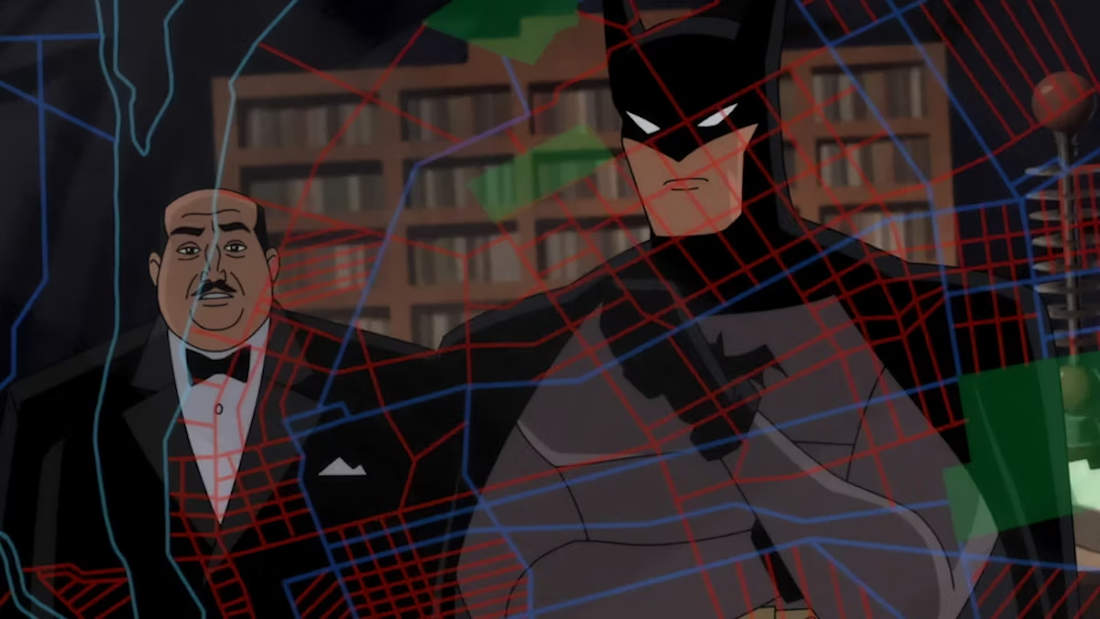
Review: Batman: Caped Crusader (Season 1) – Back to crime alley
Developed by Bruce Timmy (based on the character created by Bill Finger and Bob Kane)
Starring Hamish Linklater, Krystal Joy Brown, Diedrich Bader
8/10
It’s hard to overstate the importance of Batman: The Animated Series and the effect it had on the superhero genre. Not only did it last for four years, spawning numerous spin-offs and an entire DC animated universe that lasted for decades, it also brought us the first appearance of Harley Quinn, a character that has gone on to dominate comics, media, and computer games. It even brought us the definitive voice of Batman in Kevin Conroy, who went on to play the character numerous times in both animation and games (Batman: Arkham Asylum). In many ways, it became the template for a shared superhero universe, one that still echoes strongly in the works of DC and Marvel to this day. In short, it was a big deal.
So when one of the creators of this iconic show, Bruce Timm, decides to take a different tilt on the Batman mythos, it’s enough to draw people’s attention. Add to this The Batman director Matt Reeve and comic book legends Ed Brubaker (Criminal, Gotham Central) and Greg Rucka (Whiteout, Gotham Central), and it has fans of The Dark Knight positively salivating.
Yet the internet being the internet, most of what you’re going to hear is people whining about a gender swapped Penguin.
As Gotham struggles under a gang war, a mysterious vigilante, the Batman (Hamish Linklater), appears to take on both sides. As Commissioner Gordon (Eric Morgan Stuart) struggles both to capture this masked menace and clean up his own department, District Attorney Harvey Dent (Diedrich Bader) decides to take a tilt at mayor, unleashing a series of events that will change Gotham.
Batman: Caped Crusader dives deeper into the Dark Deco stylings of BTAS, making it more than just surface stylings. It brings the setting into what appears to be the 1940s (albeit with colour blind casting), drawing upon the pulp adventures, gangster films, and film noir cinema that shaped the character during his early comic book years. It brings to life a Gotham mired in systemic corruption at every level—political, judicial and police. This is a city that can be a rich person’s playground or a poverty-fueled nightmare, with a system of vast inequality depending on the status of who it is applied to. This corruption is more than mere setting; it is woven into the plot, becoming a driving factor for most of the characters as they either succumb to its temptation or strive against it.
You can see the influences here in many of the character’s greatest tales. Miller’s ‘Batman: Year One’ is quintessential here, as we see a young Bruce, new to the cowl, take on an established system of mob graft. Yet Batman: Caped Crusader draws on influences across the Detective’s career, from the Golden and Bronze Ages into the modern era and films (especially The Dark Knight and The Batman).
Alright, time to address The Penguin in the room. The first episode presents a gender-flipped Penguin (Minnie Driver), which is a little distracting and, at first glance, unnecessary. Yet the portrayal remains true to the iconic villain and actually emphasises how callous they are in one shocking scene. However, what it does do is highlight the Elseworlds nature of this tale and show a willingness to tinker with characters while remaining true to their core concept.
As such, all of the characters have something changed that works into the central theme of corruption and inequality. Hence Bruce’s relationship with Alfred (Jason Watkins) is far less cordial than we’ve ever seen; Harvey Dent is more of a political opportunist; Commissioner Gordon’s post may be tenuous due to his skin colour; and Barbara Gordon (Krystal Joy Brown) is working as a public defender. This all comes to a head in the two-part season finale, with the introduction of Two Face. Here they don’t just make the character a dark reflection of Batman, but have a very interesting take on his psyche (notice which side of the face is showcased when each of his personalities talk) and his creation.
There is also the interesting tactic of allowing many of the traditionally side characters to be the focus of much of the series, rather than focusing solely on Batman. It enhances the verisimilitude of the piece, gives us more insight into the crumbling system, and enhances the brooding presence of Batman. This is not to say we never get Batman-focused episodes or avoid fantastical themes (episode 6 Night Ride is a great example of both); rather, it is a case of less is more.
In short, this owes a lot to classic film noir, giving us complex character motivations playing in a world crumbling to corruption. It’s a perfect place to thematically set a Batman tale, given the character’s 1939 creation. It certainly makes sense with the inclusion of Brubaker and Rucka in the production, due to their works directly inspired by that era of cinema (Fatale, The Fade Out), their neo-noir work (Criminal, Whiteout), and their Batman police procedural (Gotham Central). There’s a lot of respect given to the genre form, as well as loving references to classic noir scattered throughout.
However, that does come at a price. Firstly, the performances are a little more stoic than we’re used to. Keeping in line with the films of the era, the voice actors are less likely to stretch to extremes of effect than they would in our era. As such, it can read as a little flat to some viewers. Secondly, this philosophy affects the action set pieces, and although the series is by no means short on action, those sequences are not as exaggerated and pulpy as recent superhero offerings. Finally, there is the pace, which, again, might be considered slow by modern sensibilities.
All of these arise from aping classic cinema of the era, and although I respect the decision, I acknowledge it may be detrimental to some viewers. For me personally, this is a chocolate and peanut butter situation. Two of my favourite things combined into one unique piece.
The end result, though, is something phenomenal. Batman: Caped Crusader feels like a refinement of BTAS, designed from the ground up with an adult audience in mind. True, this may be at the loss of some of the cartoon’s pulp flair, but it replaces it with a hard-as-nails crime story that would make James Ellroy proud.
DAVID O’CONNELL
